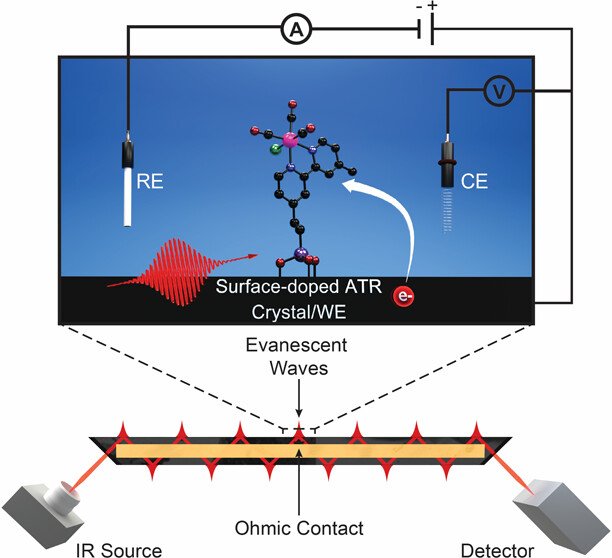In Situ Attenuated Total Reflectance Infrared Spectroelectrochemistry (ATR-IR-SEC) for the Characterization of Molecular Redox Processes on Surface-Proximal Doped Silicon ATR Crystal Working Electrode
In situ mid-infrared spectroscopy is a powerful technique for understanding the mechanism of CO₂ reduction (CO₂R) catalysts because it enables the direct detection of catalytic intermediates and products. Moreover, spectroelectrochemistry (SEC), the coupling of spectroscopy with electrochemistry, allows spectroscopic changes to be correlated with applied potentials to reveal potential-dependent intermediates that are often relevant to photoelectrochemical reactions. Hybrid photoelectrodes, composed of a narrow bandgap semiconductor, like silicon (Si), with a covalently linked molecular catalyst, are a promising platform for sunlight-driven catalysis, but characterization of the catalytic mechanism(s) is challenging under photoelectrochemical conditions, particularly when the catalyst is present in monolayer or less concentrations. Here, we have developed a new strategy to use multiple-reflection attenuated total reflectance IR spectroscopy (ATR-IR) coupled with electrochemistry to characterize catalysts directly integrated with a semiconductor surface under applied potential. We show that by surface-proximal n-type or p-type doping of the top ∼100 to 200 nm of the crystal surface, Si ATR crystals can be used simultaneously as the internal reflection element and semiconductor working electrode for ATR-IR-SEC measurements. The surface-proximal doping strategy yields a quasi-equipotential surface with excellent infrared transparency that would have been compromised by free carrier absorption if the crystal was uniformly doped. This approach permits the catalytically active functionalized surface to be directly probed without modification and overcomes signal-to-noise limitations of other strategies that use separately deposited working electrodes on Si ATR crystals. Proof-of-concept ATR-IR-SEC spectra were collected during the reduction and oxidation of monolayers of Re- and Ru-based transition-metal carbonyl complexes, respectively, verifying the viability of the technique to probe redox processes associated with CO₂R catalysts on Si electrode surfaces with high sensitivity.
Bottum, S. R; Teitsworth, T. S.; Han, Q.; Orr, A. D.; Jin-Sung Park, J.-S.; Jia, X.; Cappuccino, C.; Layne, B. H.; Hazari, N.; Concepcion, J. J.; Donley, C. L.; Polyansky, D. E.; Lockett, M. R.; Cahoon, J. F.; Grills, D. C. In Situ Attenuated Total Reflectance Infrared Spectroelectrochemistry (ATR-IR-SEC) for the Characterization of Molecular Redox Processes on Surface-Proximal Doped Silicon ATR Crystal Working Electrodes. J. Phys. Chem. C 2023, 127 (14), 6690-6702. https://pubs.acs.org/doi/10.1021/acs.jpcc.2c08991

